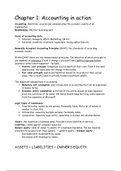Samenvatting
IBEB Accounting Summary (English). Grade: 8
- Instelling
- Erasmus Universiteit Rotterdam (EUR)
Comprehensive summary for Accounting, includes all content from the book and the lectures. This summary enabled me to get one of the highest grades in the year (top 10%). Uitgebreide samenvatting voor Accounting aan de Erasmus Universiteit.
[Meer zien]





